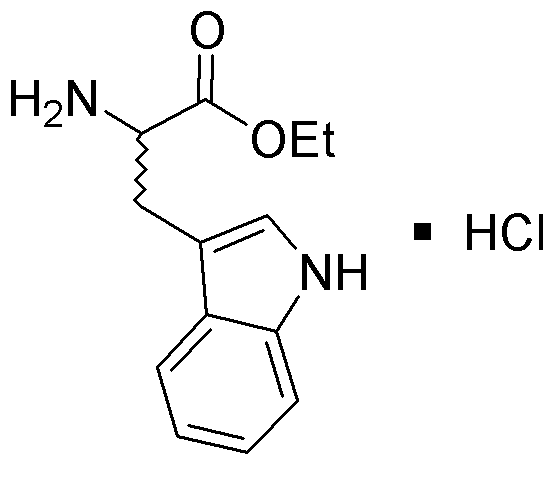DL-Tryptophan ethyl ester hydrochloride is widely utilized in research focused on:
- Nutritional Supplements: This compound is often used in dietary supplements aimed at improving mood and sleep quality due to its role as a precursor to serotonin.
- Pharmaceutical Development: It plays a significant role in the synthesis of pharmaceuticals, particularly those targeting neurological disorders, by enhancing serotonin levels in the brain.
- Animal Feed Additives: In the agricultural sector, it is incorporated into animal feed to promote growth and improve overall health in livestock.
- Biochemical Research: Researchers utilize this compound to study metabolic pathways and the effects of tryptophan derivatives on various biological processes.
- Cosmetic Formulations: It is also found in cosmetic products for its potential skin benefits, such as hydration and soothing properties, making it appealing for skincare formulations.
General Information
Properties
Safety and Regulations
Applications
DL-Tryptophan ethyl ester hydrochloride is widely utilized in research focused on:
- Nutritional Supplements: This compound is often used in dietary supplements aimed at improving mood and sleep quality due to its role as a precursor to serotonin.
- Pharmaceutical Development: It plays a significant role in the synthesis of pharmaceuticals, particularly those targeting neurological disorders, by enhancing serotonin levels in the brain.
- Animal Feed Additives: In the agricultural sector, it is incorporated into animal feed to promote growth and improve overall health in livestock.
- Biochemical Research: Researchers utilize this compound to study metabolic pathways and the effects of tryptophan derivatives on various biological processes.
- Cosmetic Formulations: It is also found in cosmetic products for its potential skin benefits, such as hydration and soothing properties, making it appealing for skincare formulations.
Documents
Safety Data Sheets (SDS)
The SDS provides comprehensive safety information on handling, storage, and disposal of the product.
Product Specification (PS)
The PS provides a comprehensive breakdown of the product’s properties, including chemical composition, physical state, purity, and storage requirements. It also details acceptable quality ranges and the product's intended applications.
Certificates of Analysis (COA)
Search for Certificates of Analysis (COA) by entering the products Lot Number. Lot and Batch Numbers can be found on a product’s label following the words ‘Lot’ or ‘Batch’.
*Catalog Number
*Lot Number
Certificates Of Origin (COO)
This COO confirms the country where the product was manufactured, and also details the materials and components used in it and whether it is derived from natural, synthetic, or other specific sources. This certificate may be required for customs, trade, and regulatory compliance.
*Catalog Number
*Lot Number
Safety Data Sheets (SDS)
The SDS provides comprehensive safety information on handling, storage, and disposal of the product.
DownloadProduct Specification (PS)
The PS provides a comprehensive breakdown of the product’s properties, including chemical composition, physical state, purity, and storage requirements. It also details acceptable quality ranges and the product's intended applications.
DownloadCertificates of Analysis (COA)
Search for Certificates of Analysis (COA) by entering the products Lot Number. Lot and Batch Numbers can be found on a product’s label following the words ‘Lot’ or ‘Batch’.
*Catalog Number
*Lot Number
Certificates Of Origin (COO)
This COO confirms the country where the product was manufactured, and also details the materials and components used in it and whether it is derived from natural, synthetic, or other specific sources. This certificate may be required for customs, trade, and regulatory compliance.


